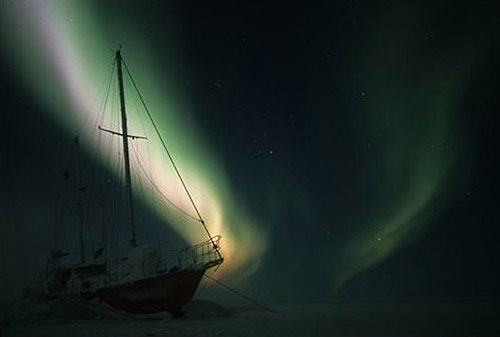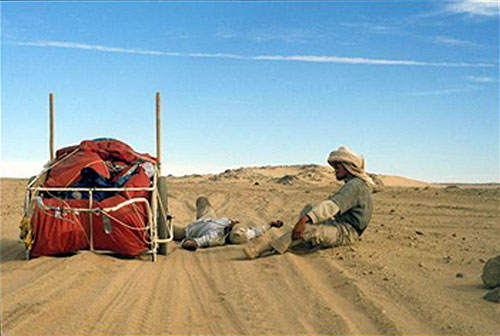 Adventurers head down Yukon
to monitor permafrost
Adventurers head down Yukon
to monitor permafrost
By Ned Rozell
February 15, 2007
Thursday PM
Kenji Yoshikawa has seen a good portion of the planet he calls
home. Born in Tokyo, he has biked across Australia, walked the
Sahara, skied across Greenland and to the South Pole, and he
made his way to Alaska by sailing to Barrow from Japan.
In Barrow, he let his boat freeze into the sea ice. He spent
a dark winter on the tilted boat, enjoying solitude and working
on his college degree. He calls that period "the greatest
time in 43 years of life."
 Kenji Yoshikawa's 43-foot
boat, the HokiMai, frozen
Kenji Yoshikawa's 43-foot
boat, the HokiMai, frozen
into Elson Lagoon near Barrow in winter 1996.
Photo by Kenji Yoshikawa.
Yoshikawa is a permafrost scientist at the University of Alaska
Fairbanks who will soon head down the Yukon River by snowmachine
to visit village schools. Along the way, he hopes to establish
permafrost observatories at the schools by drilling through soil
that has remained frozen for at least one year. Much of the permafrost
along the Yukon River is within one degree of thawing.
Yoshikawa wants to include
villages on the Yukon in a "permafrost health monitoring
program" and work with students and teachers on the permafrost
boreholes he hopes to drill at each site. The boreholes are about
2 inches in diameter; he snakes a cable down the hole that gives
permafrost temperature readings from about 20 feet down to the
surface. He has already installed such observatories at eight
schools, from Barrow to Glennallen.
His Yukon River trip will begin in Manley Hot Springs on Feb.
28 as a two-snowmachine expedition with Tohru Saito, who works
at the International Arctic Research Center on a variety of projects,
including the weather station at 18,733 feet on Denali.
The pair will travel with two large sleds carrying provisions
and a drill that can penetrate permafrost and the frozen gravel
soils they expect to encounter in the villages. From Manley,
they hope to move overland to Tanana and then down the Yukon,
giving presentations to classes and drilling permafrost observatories
as they go. Depending on how well the drilling goes, the pair
might continue down the river until they run out of villages.
"If everything goes well, we'll end up at Emmonak,"
Yoshikawa said.
Yoshikawa and Saito will complete the journey one way or another
in a few weeks' time. They'll have to, because Yoshikawa has
more planned for spring, and summer is booked too. He'll make
a trip to Fort Yukon from Circle by snowmachine in late March
to establish a permafrost-monitoring hole there, and snowmachine
from Kotzebue to Noatak to Kivalina in April. Before he even
starts snowmachine travel in Alaska, he's going to Hawaii to
see if he can drill a borehole into the frozen ground on 13,796-foot
Mauna Kea.
 Kenji and Eiji Yamamoto,
Sahara: Kenji Yoshikawa and his travel partner Eiji
Kenji and Eiji Yamamoto,
Sahara: Kenji Yoshikawa and his travel partner Eiji
Yamamoto take a break from pushing their cart full of water and
other
supplies across the Sahara Desert in the winter of 1984-1985.
Photo by Kenji Yoshikawa.
After he completes his Alaska work in spring, Yoshikawa will
travel to Canada, Mongolia, Siberia and Greenland in summer and
fall, again establishing identical sites to monitor how permafrost
is doing now and in the future. First, though, he has to invent
a drill bit that will bite through the gravel he anticipates
at the Yukon River schools. He's now experimenting with a few
different models in his garage on Birch Hill in Fairbanks, and
he doesn't seem to be sweating the deadline. You might expect
that from someone with his history of outdoor problem solving.
On his trip to Antarctica, for example, he designed the sleds
for the expedition and also the Teflon pans to bake the high-calorie
biscuits that form-fit to the bottom of the sleds.
Yoshikawa has met people throughout the world who like him and
help him on his treks and scientific missions. While in Barrow,
he met his wife, Arva Chiu, and they've had two children, Maya
and Kent, who are now ages 6 and 7. After toning down his adventures
while the kids were younger, Yoshikawa is happy the permafrost
project is getting him back on the trail, where he can combine
adventure and science.
"This program is very much back to my passion," he
said.
This column is provided
as a public service by the Geophysical Institute, University
of Alaska Fairbanks, in cooperation with the UAF research community.
Ned Rozell is a science writer at the institute.
E-mail your news &
photos to editor@sitnews.us
Publish A Letter on SitNews Read Letters/Opinions
Contact the Editor
SitNews
©2006
Stories In The News
Ketchikan, Alaska
|


